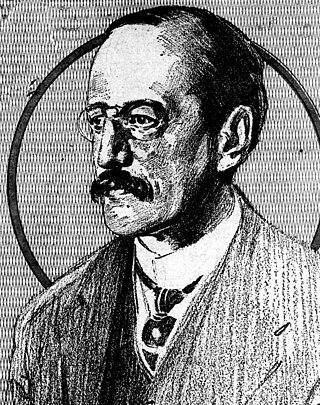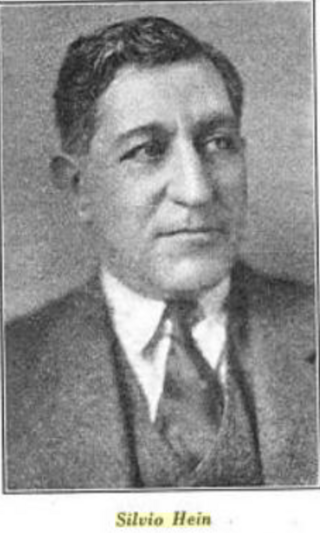
Otto Abels Harbach, born Otto Abels Hauerbach was an American lyricist and librettist of nearly 50 musical comedies and operettas. Harbach collaborated as lyricist or librettist with many of the leading Broadway composers of the early 20th century, including Jerome Kern, Louis Hirsch, Herbert Stothart, Vincent Youmans, George Gershwin, and Sigmund Romberg. Harbach believed that music, lyrics, and story should be closely connected, and, as Oscar Hammerstein II's mentor, he encouraged Hammerstein to write musicals in this manner. Harbach is considered one of the first great Broadway lyricists, and he helped raise the status of the lyricist in an age more concerned with music, spectacle, and stars. Some of his more famous lyrics are "Smoke Gets in Your Eyes", "Indian Love Call" and "Cuddle up a Little Closer, Lovey Mine".

Jean Schwartz was a Hungarian-born Jewish American composer and pianist. He is best known for his work writing the scores for more than 30 Broadway musicals, and for his creation of more than 1,000 popular songs with the lyricist William Jerome. Schwartz and Jerome also performed together on the vaudeville stage in the United States; sometimes in collaboration with Maude Nugent, Jerome's wife, and the Dolly Sisters. Schwartz was married to Jenny Dolly from 1913 to 1921.
The Siren is a musical in three acts, adapted from the operetta Die Sirene, with music by Leo Fall and text by Leo Stein and A. M. Willner. This was first performed in Vienna on January 5, 1911.

Alfred Maria Willner was an Austrian writer, philosopher, musicologist, composer and librettist.
Henry Martyn Blossom Jr. was an American writer, playwright, novelist, opera librettist, and lyricist. He first gained wide attention for his second novel, Checkers: A Hard Luck Story (1896), which was successfully adapted by Blossom into a 1903 Broadway play, Checkers. It was Blossom's first stage work and his first critical success in the theatre. The play in turn was adapted by others creatives into two silent films, one in 1913 and the other in 1919, and the play was the basis for the 1920 Broadway musical Honey Girl. Checkers was soon followed by Blossom's first critical success as a lyricist, the comic opera The Yankee Consul (1903), on which he collaborated with fellow Saint Louis resident and composer Alfred G. Robyn. This work was also adapted into a silent film in 1921. He later collaborated with Robyn again; writing the book and lyrics for their 1912 musical All for the Ladies.
The Strollers is a musical in two acts and a prologue with music by Ludwig Engländer and a book and lyrics by Harry B. Smith. Set in Austria, the work is based on Leopold Krenn and Karl Lindau's libretto for the 1899 operetta Die Landstreicher by the composer Carl Michael Ziehrer. The work premiered on Broadway at the Knickerbocker Theatre on June 24, 1901. It closed at that theatre on August 31, 1901 after 70 performances. The Broadway production was directed by A. M. Holbrook and produced by George W. Lederer, Sam Nixon and J. Fred Zimmerman. The sets were designed by D. Frank Dodge and Ernest Albert, and the costumes were designed by Caroline Siedle. The production starred Francis Wilson as August Lump, Irene Bentley as Bertha, Eddie Foy as Kamfer, Marie George as Mimi, Harry Gilfoil as the Prince de Bomsky, Wilmer Bentley as Rudi von Rodenstein, and Louise Lawton as Anna.

Ida Hawley was a musical comedy actress and soprano singer from Canada who worked in the U.S.
Stanislaus Stange (1862–1917) was a playwright, librettist and lyricist who created many Broadway shows in the fin-de-siecle era and early 20th century. After minor success as an actor, Stange made his career as a writer in the musical theatre, moving towards more varied theatrical work before his death.

Louise Gunning was an American soprano popular on Broadway in Edwardian musical comedy and comic opera from the late 1890s to the eve of the First World War. She was perhaps best remembered as Princess Stephanie of Balaria in the 1911 Broadway production of The Balkan Princess. During the war years Gunning began to close out her career singing on the vaudeville circuit.

Sydney Rosenfeld (1855–1931) was an American playwright who wrote numerous plays, and adapted many foreign plays. Close to fifty of his creations played on Broadway.

The Prince of Pilsen is a lost 1926 American silent romantic comedy film directed by Paul Powell and starring Anita Stewart and George Sidney. David Belasco produced the film. It was based on a 1903 Broadway musical, The Prince of Pilsen, by Frank S. Pixley and music by Gustav Luders.

Gustav Carl Luders, sometimes written Gustave Luders, was a musician who wrote the music for various songs and shows in the U.S. He was born in Bremen, Germany. He came to the U.S. in 1888 and lived in Milwaukee and then Chicago. He was known for his musical comedies. His The Prince of Pilsen was adapted into the film The Prince of Pilsen.

Frank S. Pixley was an educator, newspaper editor, playwright and lyricist. He partnered with Gustav Luders, Pixley writing words and lyrics and Luders the music for several shows. American Musical Productions describes the team as Pixley and Luders became the Rodgers and Hammerstein of the 1900s.

Louis Harrison was an actor, playwright, comedian, lyricist, librettist, and theatre director. As both a performer and playwright, he was mainly active within the genres of musical theatre and light opera.
Frederic G. Ranken was an American librettist, lyricist, and playwright for light operas and musicals staged on Broadway from 1899 through 1907. His greatest success was the libretto for Reginald De Koven's 1905 comic opera Happyland. He also wrote libretti for composers Victor Herbert and Ludwig Engländer, and was a lyricist for composers Alfred Baldwin Sloane and Gustave Kerker among others. As a playwright he wrote the books for several musicals.
Gates and Morange was a New York City based firm of designers and builders established in 1894 by brothers Frank E. Gates and Richard H. Gates, and the artist Edward A. Morange. The firm had a prolific career as scenic designers for Broadway from the 1890s through the 1930s; creating sets for more than 50 productions. The firm also created designs for trade shows, exhibitions, and businesses. While the organization's work as set designers ended after the mid-1930s, the firm continued to operate in other capacities until it closed in 1953.
D. Frank Dodge was an American scenic designer who had a prolific career on Broadway from the 1890s into the early 1920s. Theatre historian Gerald Bordman in The Concise Oxford Companion to American Theatre stated that Dodge was "one of the busiest turn‐of‐the‐century set designers" who "specialized in colorful settings for musicals".
The White Hen is a musical in two acts with music by composer Gustav Kerker, a book by Roderic C. Penfield, and lyrics co-authored by Penfield and Paul West. Set in Tyrol, Austria, the story takes place at an inn, 'The White Hen', owned by Hensie Blinder. The musical begins after Blinder returns from a trip to Vienna in which he engaged a matrimonial agency to help him find a wife. Upon his return to the inn, several women arrive in response to the advertisement placed by the agency and a comedy of errors ensues; including Blinder mistakenly believing he has committed the crime of bigamy.

The Red Moon is a musical or operetta in three acts with music by J. Rosamund Johnson and both book and lyrics by Bob Cole. Additional music was contributed by James Reese Europe who composed the song "Sambo" for the show, and co-wrote the song "Ada " with Cole and lyrics by Charles A. Hunter. Labeled and marketed by its creators as a "sensation in red and black", the work has been classified variously by theatre scholars as a musical and an operetta. The show was created by African Americans and starred an all-Black cast in its original 1908–10 production. The show is regarded as historically important to American theatre because it was the first Broadway show to depict alliances between African Americans and Native Americans.

Silvio Hein was an American composer, songwriter, conductor, and theatrical producer. He was a songwriter for Tin Pan Alley and composed the scores to fourteen Broadway musicals. His most successful stage work was the 1917 musical Flo-Flo which he created with the French librettist and playwright Fred de Gresac. His songs were also interpolated into musicals created by others, including The Little Duchess and Ziegfeld Follies. In addition to his work writing music, he also worked as both a conductor and producer on Broadway. In 1914 he was a founding member of the American Society of Composers, Authors and Publishers.













